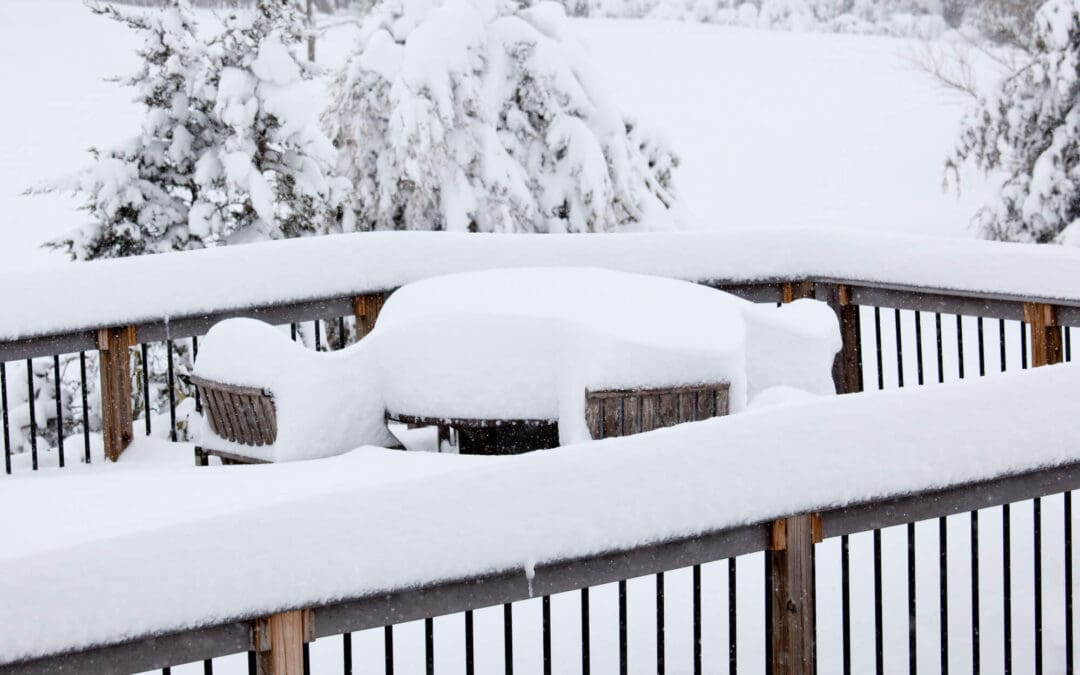As the temperatures drop and moisture becomes more frequent, your deck faces months of harsh conditions. Taking steps to winterize your deck now helps prevent rot, warping, fading, and structural damage that could develop when wood or composite materials are repeatedly exposed to freezing temperatures. A bit of work before winter sets in will extend the life of your deck, keep it looking beautiful, and save you from costly repairs in the spring.
How to Winterize Your Deck with a Deep Clean
A thorough cleaning is one of the most effective ways to winterize your deck. Dirt, leaves, pollen, and mildew trap moisture against the surface, and once freezing temperatures hit, that trapped moisture may expand and create cracks or surface damage. Cleaning the deck allows you to start with a fresh, dry surface before the weather turns. Using a gentle deck cleaner and a scrub brush works well for removing buildup. If you own a pressure washer, using it on a low setting will help without damaging the boards. Once the deck is clean, it should be allowed to dry fully before moving to any sealing or protective steps. Inspecting the deck while cleaning makes it easier to identify areas that need extra care. Loose boards, popped nails, and damaged railings often become bigger issues once winter arrives. Addressing these minor issues now will enhance safety and prevent them from escalating into major repairs once the freeze-and-thaw cycle commences.
Seal and Protect: A Key Step to Winterize Your Deck
Once your deck is clean and dry, adding a protective sealant is important. A quality sealer or stain helps repel water, reduce UV damage, and prevent mold growth throughout the colder months. Choosing a penetrating sealant guarantees the product soaks into the wood rather than just coating the surface. This makes it more effective against moisture and gives your deck a richer, refreshed appearance. The application is most effective when done on a dry, mild day, allowing for proper curing. Even if your deck is made of composite materials, a protective treatment may still be helpful, as it preserves the finish and reduces fading.
Preparing Furniture and Accessories
Outdoor furniture, planters, mats, and décor all need attention as you winterize your deck. Moisture collects under furniture legs and rugs, which may cause discoloration or mildew growth. Removing or storing these items keeps your deck cleaner and safer throughout the season. If larger pieces must stay outdoors, covering them with waterproof materials helps protect both the furniture and the deck surface underneath. Planters should be emptied or moved indoors to prevent damage from expanding soil during freezing temperatures. Grills should be cleaned and covered, and any remaining food debris should be removed to avoid attracting wildlife during the winter months.
Maintaining Your Deck All Winter Long
Winterizing your deck is not a one-time task that ends when the season begins. Continuing to keep the space clear of snow and debris preserves your hard work and helps extend the life of the structure. Using a plastic shovel rather than a metal one prevents scratching the boards. Clearing snow early helps prevent ice buildup, which may damage surfaces and make the deck slippery. Checking railings and steps occasionally guarantees they remain safe for use. While you won’t spend much time lounging outside during the winter, maintaining your deck throughout the season helps protect the investment you’ve already made in preparing it.
A Strong Start to Spring Begins When You Winterize Your Deck
Taking the time to winterize your deck means you’re caring for one of the most used and appreciated areas of your home. When spring arrives, you’ll spend less time repairing damage and more time enjoying the outdoors. A well-maintained deck not only adds value to your home but also creates an inviting space for gatherings, relaxation, and warm-weather activities. By preparing early and staying attentive throughout the winter, you ensure your deck remains a safe, beautiful, and durable part of your home year after year.
Frequently Asked Questions (FAQs)
How often should I winterize my deck?
Winterizing should be done once a year, typically in the fall before temperatures begin to drop consistently.
Do composite decks need to be winterized?
Yes, composite decks still benefit from cleaning, protection, and maintenance to prevent fading, staining, or moisture damage.
Is sealing a deck necessary every year?
Most sealants last one to three years. Checking water absorption on the surface can help determine when resealing is needed.
Can I use a pressure washer to clean my deck before winter?
Yes, but it should be used on a low setting to avoid damaging the deck surface.
What happens if I don’t winterize my deck?
Skipping preparation may lead to moisture damage, mold growth, rot, cracked boards, and expensive repairs in the spring.
St. James Home Services, Inc. provides home inspections in Durham, Alamance, Caswell, Chatham, Franklin, Granville, Orange, Person, Vance, and Wake Counties of North Carolina. If your area is not listed, please call us. Contact us to schedule our services.

